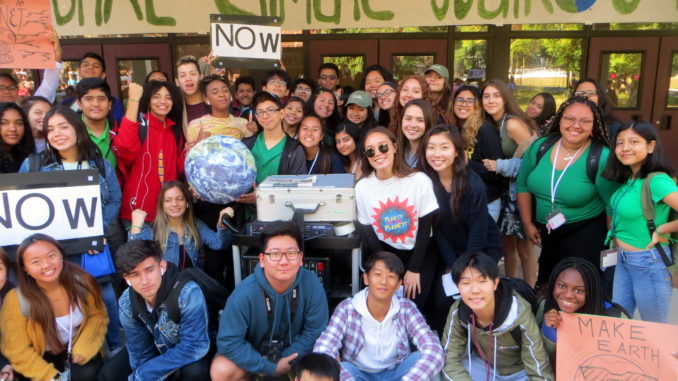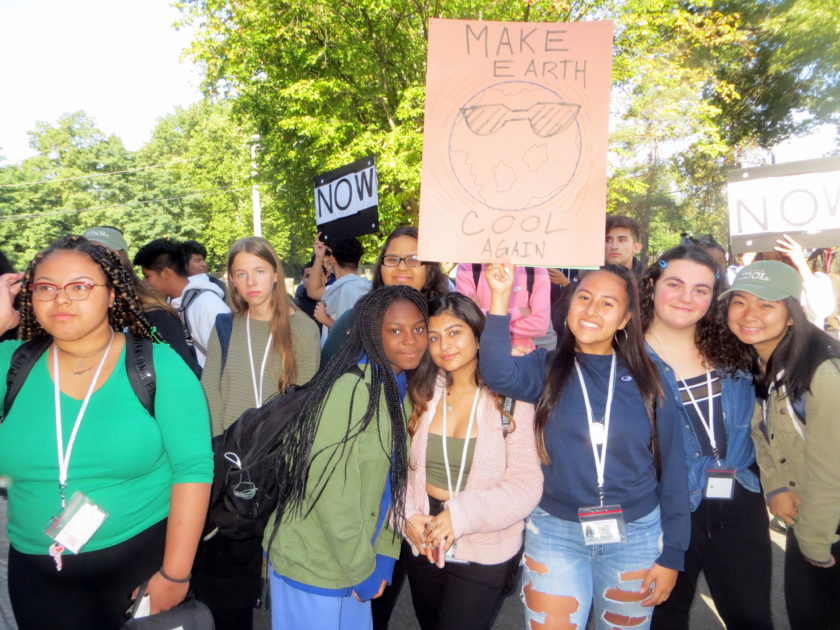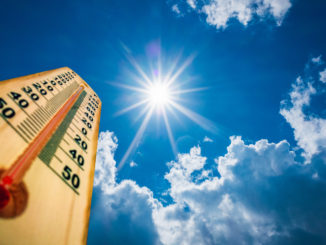
ENGLEWOOD, N.J.—On Friday, Sept. 20, over 500 students walked out of Dwight Morrow High School (DMHS) and assembled on the lawn in front of the Dizzie Gillespie Auditorium. They had come to voice their concern over the perilous crisis of our planet’s global warming and the inadequate response of elected officials.
Worldwide, global warming demonstrations led by the younger generation on Sept. 20 were monumental events in which an estimated 4 million people in every continent participated, encompassing thousands of cities and towns. Hundreds of thousands of demonstrators of all ages streamed through the streets of European capitals such as Paris, London, Berlin, Dublin and Warsaw. An estimated 300,000 protesters marched in Australia, and there were crowds in the thousands and tens of thousands in Japan, Pakistan, Manila, Rio, Thailand, Afghanistan, Nairobi, Johannesburg and many other places. Even scientists in Antarctica held a rally.
Throughout the U.S., there were massive protests in all 50 states and 1.1 million students were permitted to skip classes In New York City. Over 60,000 people, as young as 10 years old, swarmed Battery Park.
In New Jersey, demonstrations were held by high school and college students and supporters in Englewood, Montclair, Teaneck, Morristown, Paramus, Lambertville, Highland Park and New Brunswick.
Dwight Morrow Students sent clear message
Students on the DMHS campus wore green bracelets and carried handmade signs that read “There is no Planet B,” “The Earth is Changing, Why Aren’t We?” and “Make the Earth Cool Again.”
From the podium set up on the DMHS lawn, Sara Stroman from the Englewood Environmental Commission, conservationist Patches Magarro and DMHS walkout organizer Joey Liberti spoke with passion and conviction about the need for our legislators to enact climate change legislation. Liberti led the group in a rousing chant of “What do we want?” “Change!” “When do we want it?” “Now!”
Liberti said, “Students care about climate change more than ever because younger generations will have to deal with the effects and decisions made by past and present poor choices. The earth’s temperature is accelerating at an alarming rate and my generation must push legislators to act before the damage done is irreversible.
“We wish that the United States government would acknowledge climate change as a serious threat to its citizens. Then, the government should act upon the major polluters such as corporations, and restrict and monitor their outputs into society.”
Jasmine Hwang, a 12th-grader, voiced her fear of global warming.
“When I watch the news, it truly shocks me that this is the world we live in,” Hwang said. “How am I going to tell my children I lived through this? If I live through this!”
Another 12th-grader, Saba Hassan added, “How can people not see the changes happening in our world? Isn’t it obvious?”
Ben Suro, principal of Dwight Morrow High School/Academies@Englewood, came to the walkout to support the students.
“I am so happy that our student body is participating in this event to bring awareness about climate change,” Suro said. “We all need to understand how our actions, positive or negative, are playing out now. Obviously, being a part of this event is important for our youth. The world is theirs soon, and their knowledge and leadership is critical when it comes to raising awareness of how we should treat our delicate planet. I am proud of our student body recognizing the significance of caring for our only home.”

A youth movement with an increasing impact
The beginning of the youth movement for climate change has been credited to Swedish teenager Greta Thunberg, who became a lightning rod for protesting global warming. In 2018, at age 15, Thunberg demonstrated outside the Swedish parliament every day, holding up a sign calling for stronger climate action. She catapulted to fame as a role model and was featured on the cover of Time Magazine, and on a 30-minute Vice documentary titled “Make the World Greta Again.”
Thunberg motivated other students to stage similar protests in their own communities and to organize a school climate strike movement called “Fridays for Future.” After Thunberg addressed the 2018 United Nations Climate Change Conference, student strikes took place every week somewhere in the world. In 2019, there were at least two coordinated multi-city protests involving over one million pupils each.
Last March, many high school and college students walked out of their classrooms in the international climate strike. According to organizers on the Global Climate Strike website, similar protests took place in over 2,500 locations.
The walk out on Sept. 20 received even more attention, because it was a timely prelude to the Youth Climate Summit that took place on Sept. 21 at the United Nations Headquarters in New York City and the events leading up to the UN Secretary-General’s Climate Action Summit on Monday, Sept. 23.
Greta Thunberg was back in New York City on Sept. 20 and she addressed the U.N. Youth Climate Summit the following day along with 700-plus other young activists.
The Youth Climate Summit is an important platform for young activists, innovators and entrepreneurs from all walks of life to showcase their solutions at the UN and to engage with decision makers on the issue of climate change and global warming.

The participants demanded that industrialized nations reduce their consumption of coal, oil and gas and supply money and technology to poorer nations so they can adapt to green energy.
After listening to Thunberg and other young activists, Secretary-General Antonio Guterres called it a turning point in the fight against global warming.
The students at DMHS as well as millions of other activists around the world have plenty of data to support their concerns. Scientists predict that the earth’s temperature will increase by 3 degrees by 2050. They report that the global land and ocean surface temperature for May 2019 was 0.85 degrees Celsius (1.5 degrees Fahrenheit) above the 20th century average and the fourth highest May temperature departure from average since global records began in 1880.
According to other data, this summer, 36 stations across Japan set new all-time maximum temperature records. Of note, the station in Obihiro set a new all-time temperature of 38.8 degrees Celsius (101.8 degrees Fahrenheit), exceeding the previous record set on July 12, 1924, by 1.0 degrees Celsius (1.8 degrees Fahrenheit).
Israel also experienced record-breaking temperatures in May, with several locations reporting temperatures soaring between 43.0–45.0 degrees Celsius (109–113 degrees Fahrenheit).
Above-average temperatures were also present across much of New Zealand. Hanmer Forest’s maximum temperature for May 2019 was 18.1 degrees Celsius (64.6 degrees Fahrenheit), the highest temperature since its records began in 1906.
In past decades, people discredited the notion that the rapidly rising increase in carbon dioxide, produced by the burning of fossil fuels, and other heat trapping greenhouse gases such as methane, nitrous oxide and fluorinated gases, were degrading the environment. The mere mention of “global warming” elicited mockery and dismissal as “voodoo science.”
But, most people now realize that global warming is a very real problem that needs real solutions, solutions that have to be put into motion now. According to the International Panel on Climate Change 140 million tons of greenhouse gas emissions are being spewed into the world’s atmosphere every day.
But it is no longer just scientific journals, but also the general media that is reporting that ice sheets are breaking off in Antarctica and Greenland, that sea levels are rising, and this summer it was front page news when over 1,500 people died in France during a sweltering heat wave (as well as hundreds of other heat related deaths in other European countries). As such, 72% percent of Americans polled finally admit that the weather is becoming more extreme and problematic.
And these highly visible climate aberrations—extreme heat waves, droughts, severe hurricanes causing inland as well as coastal destruction, dying of coral reefs, etc., are now mobilizing people to challenge elected leaders’ insufficient responses.
Although the U.S., which has produced the most gas emissions, has been dragging its feet over reducing greenhouse emissions, other countries are stepping up to the plate. The German Cabinet just announced a $60 billion package of measures to curb greenhouse gas emissions.
The business world is also taking action. On Sept. 20, 400 companies closed for the day, including Amazon, Microsoft, Ben and Jerry’s, Burton, Patagonia, Soda Stream and scores more.
In addition to these broad gestures, individuals have to realize that they, too, play a role in saving the planet.
At the DHMS walkout, Liberti said, “Small differences can do a lot, such as recycling, using public transportation, carpooling and monitoring how much electricity you use. Differences such as eating less meat and reusing items like shopping bags and water bottles can truly make an impact. There are many bio-degradable options to common plastic that are easily accessible to the public.”
Although awareness of global warming is inter-generational, the fact that young people are pumped up with energy and passion and playing a highly visible role makes a big difference. As the crisis of our planet’s future galvanizes the world, events like the massive Sept. 20 student walkout and the Youth Climate Summit demonstrate how millions of young people are demanding that countries as well as individuals take immediate action, and they are looking to the U.S. to play a leading role.
At the DMHS walkout, an 11th grader, Bella Carbone, made a dramatic declaration: “The US has always been a pioneer for the global community. This is a real crisis! Why is change taking so long?”
Hillary Viders, Ph.D. is the author of Marine Conservation for the 21st Century. She has consulted with NOAA on climate change and was a member of Vice President Al Gore’s committee on global warming in Washington D.C. in the 1990s.

